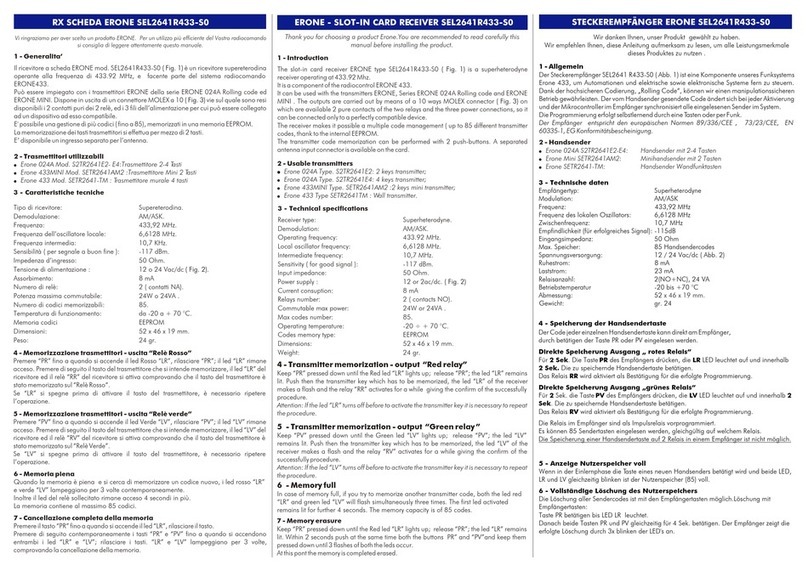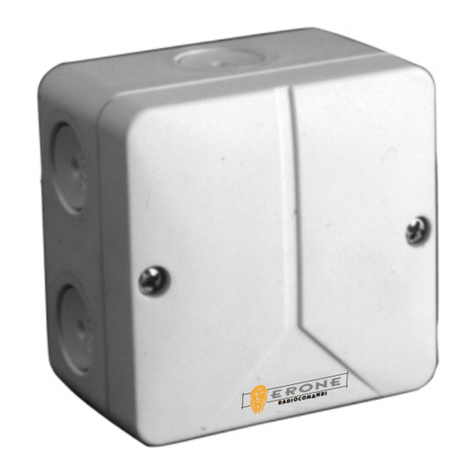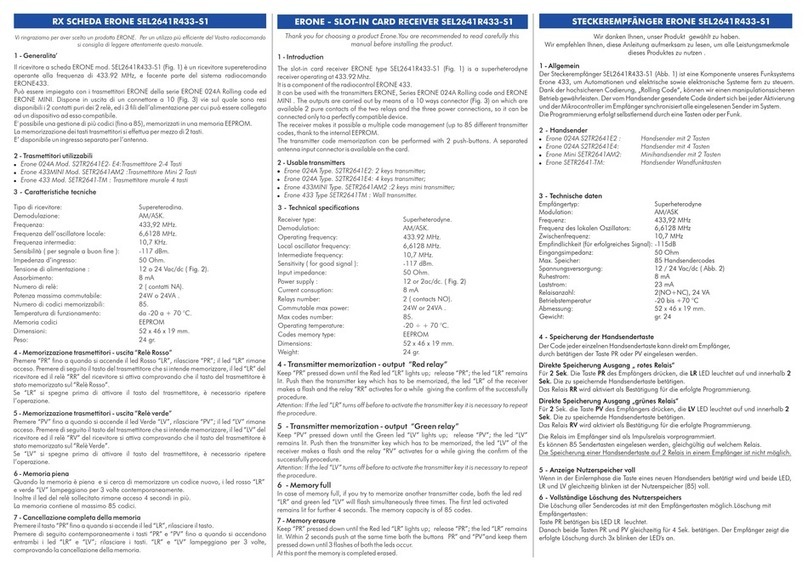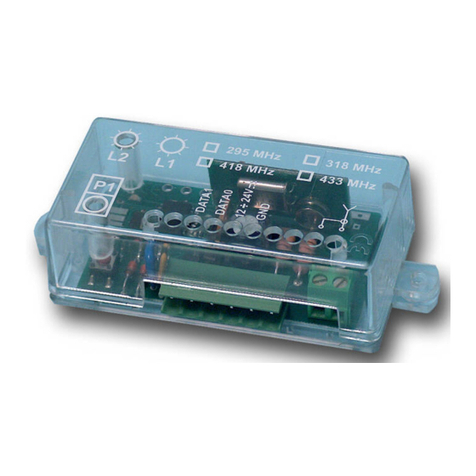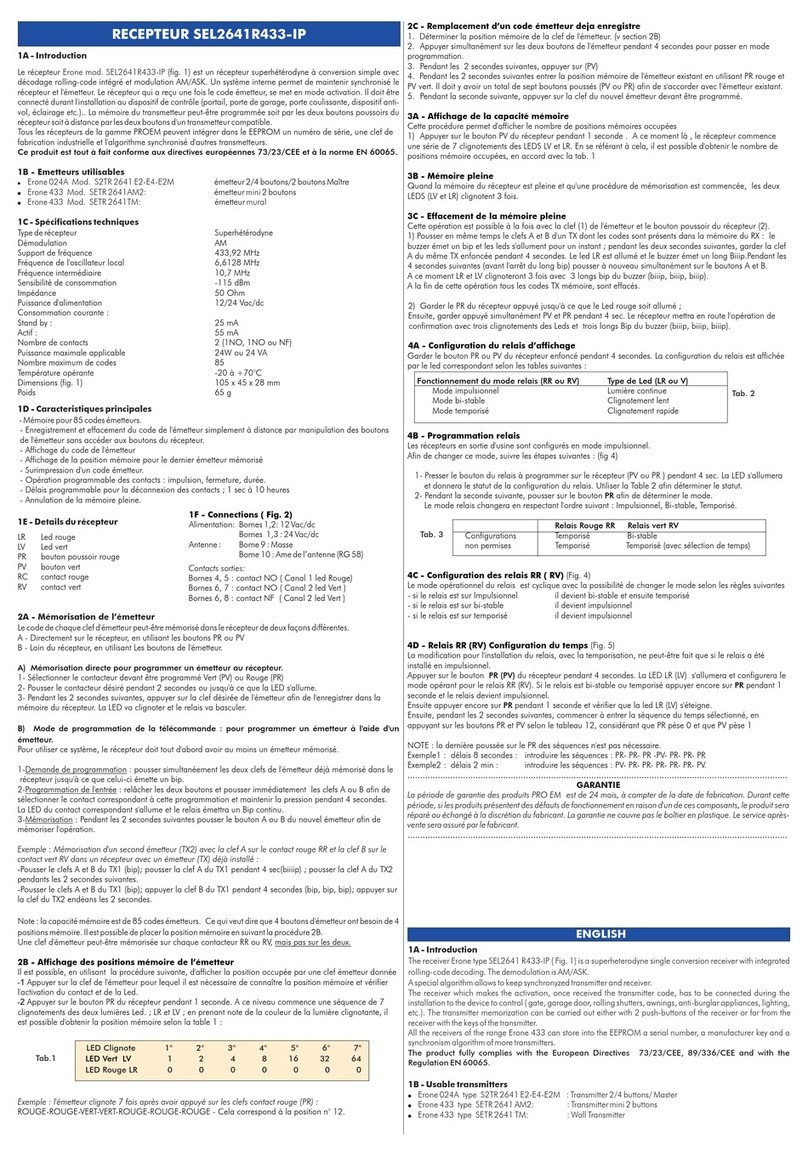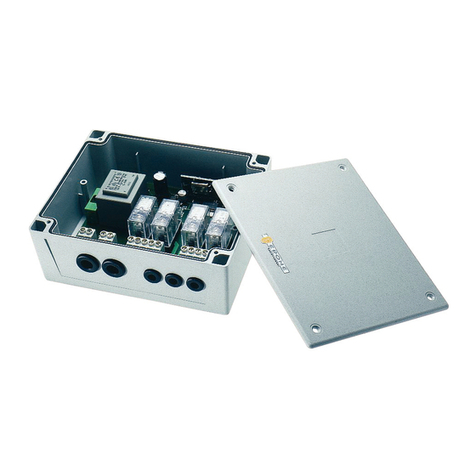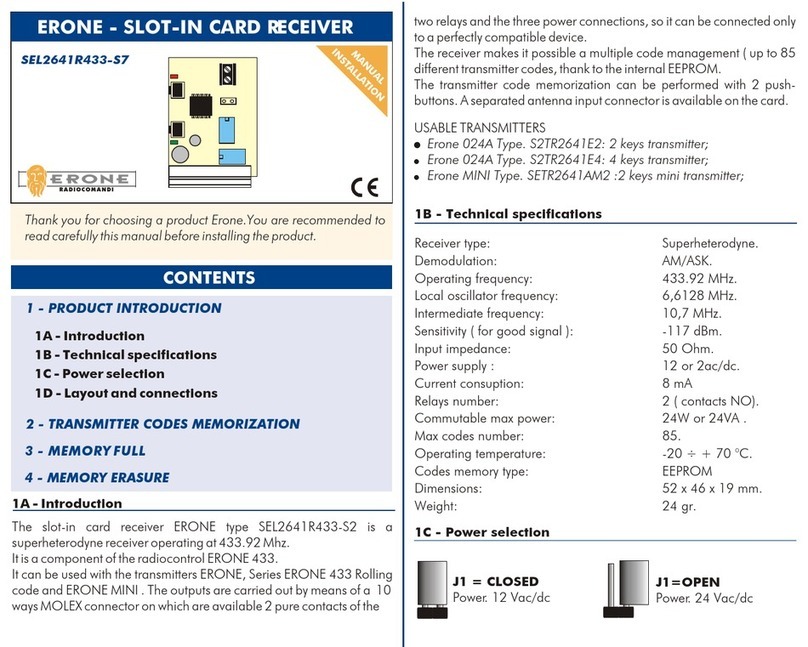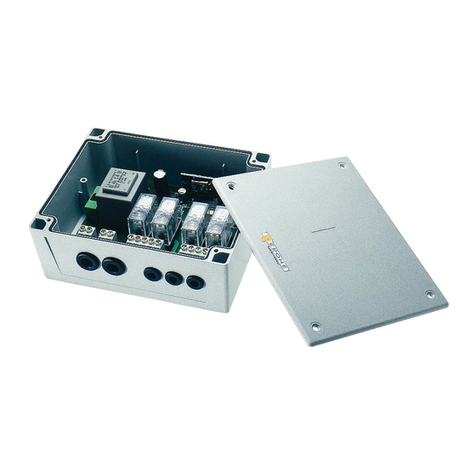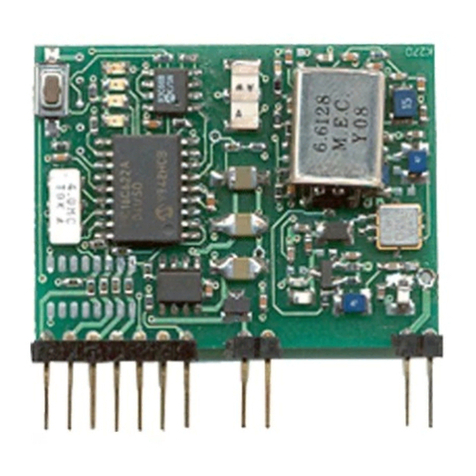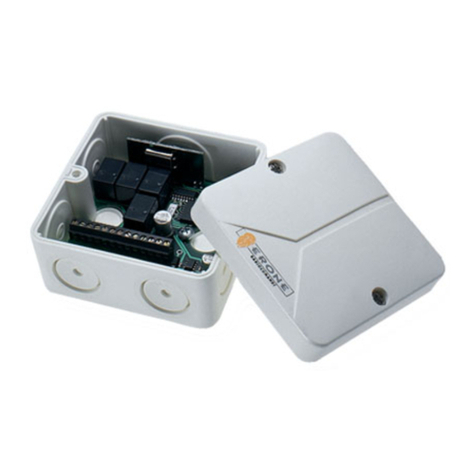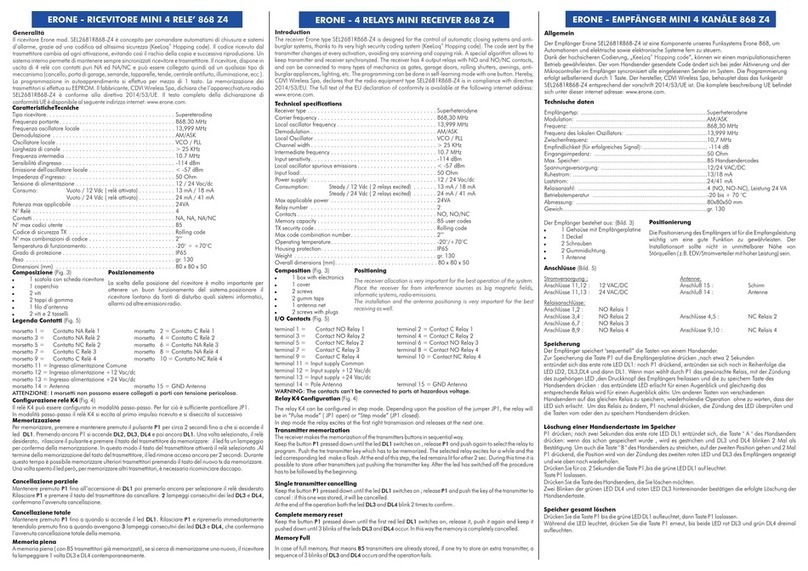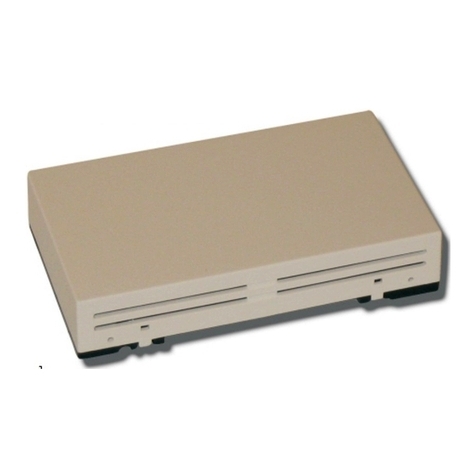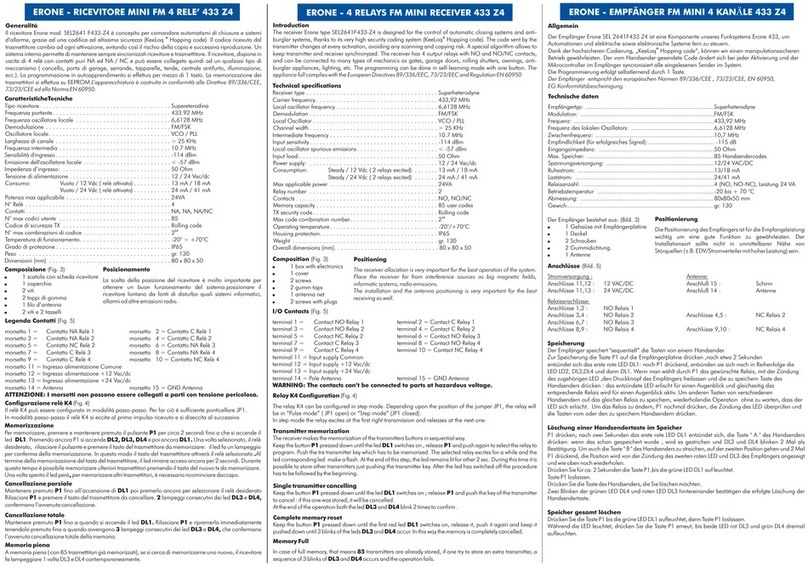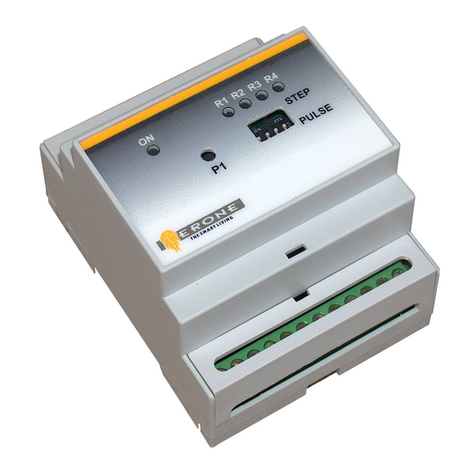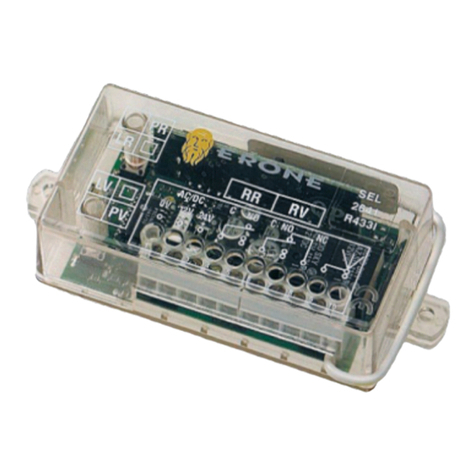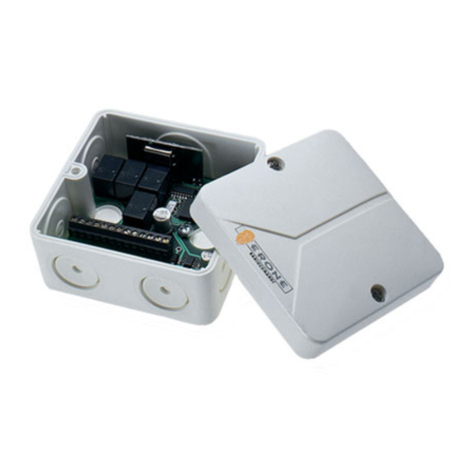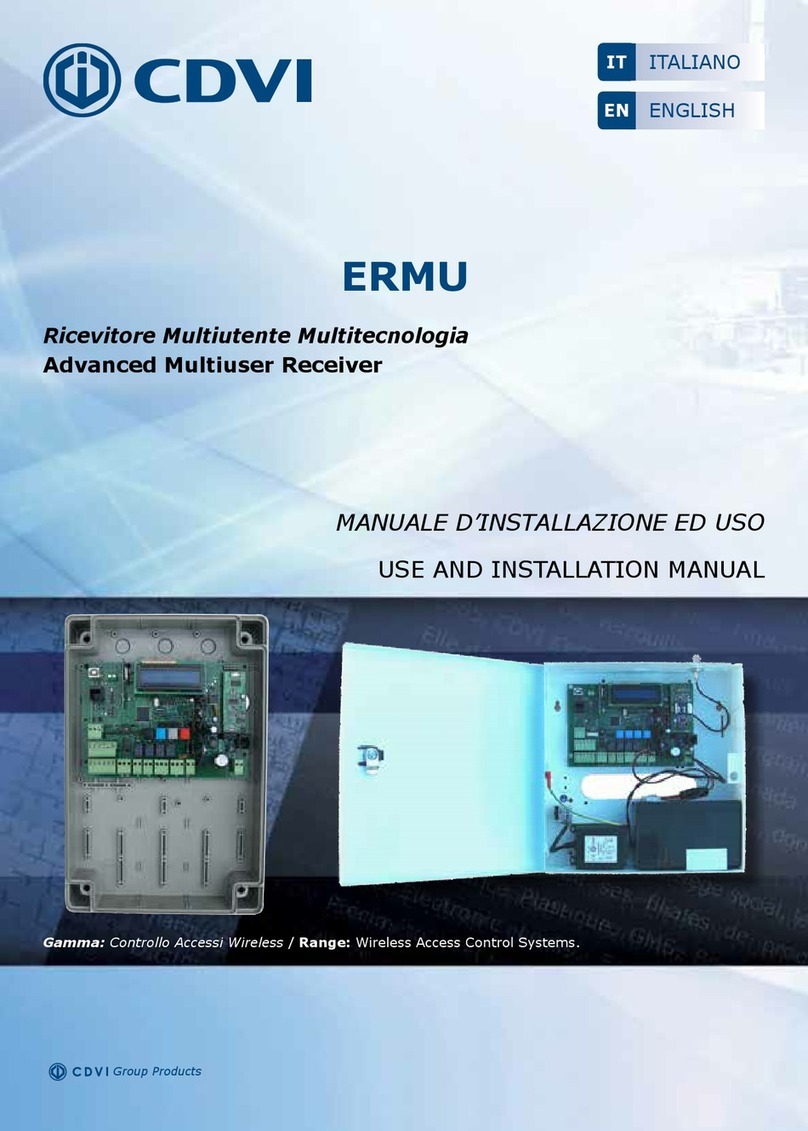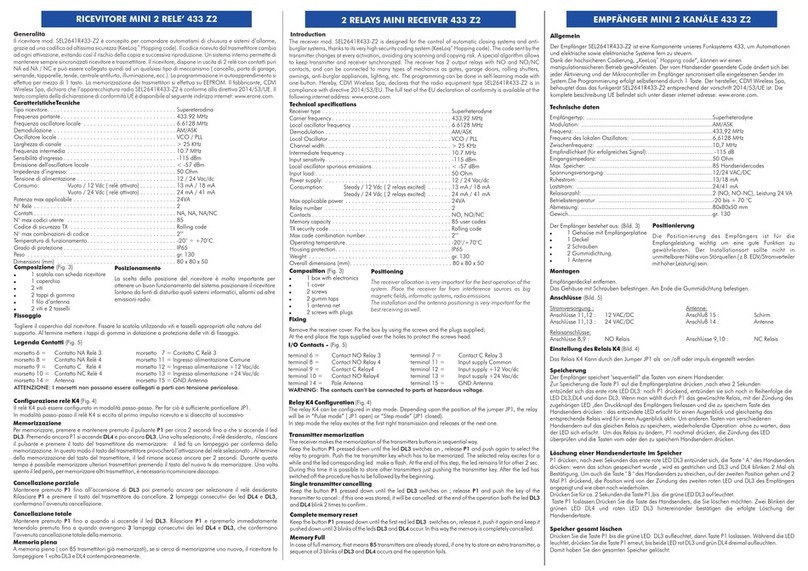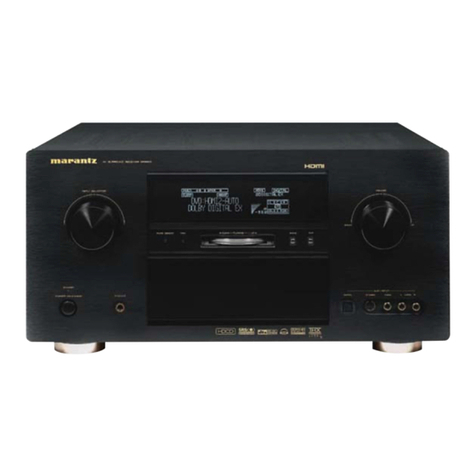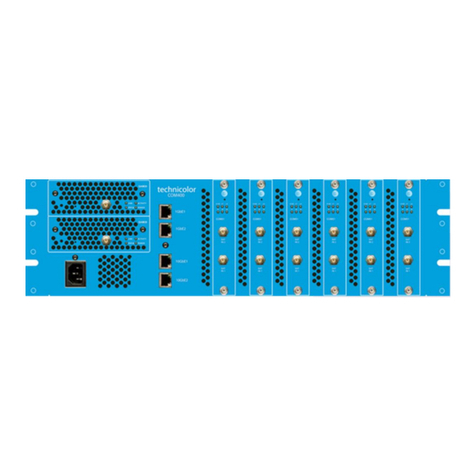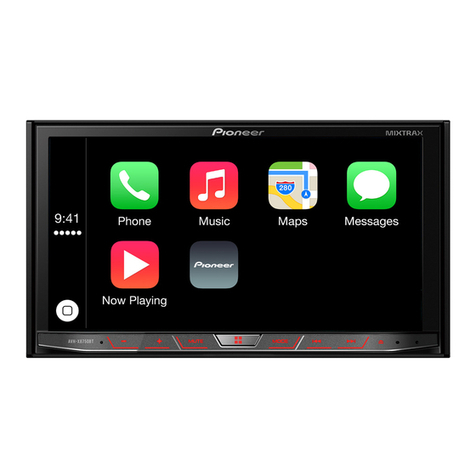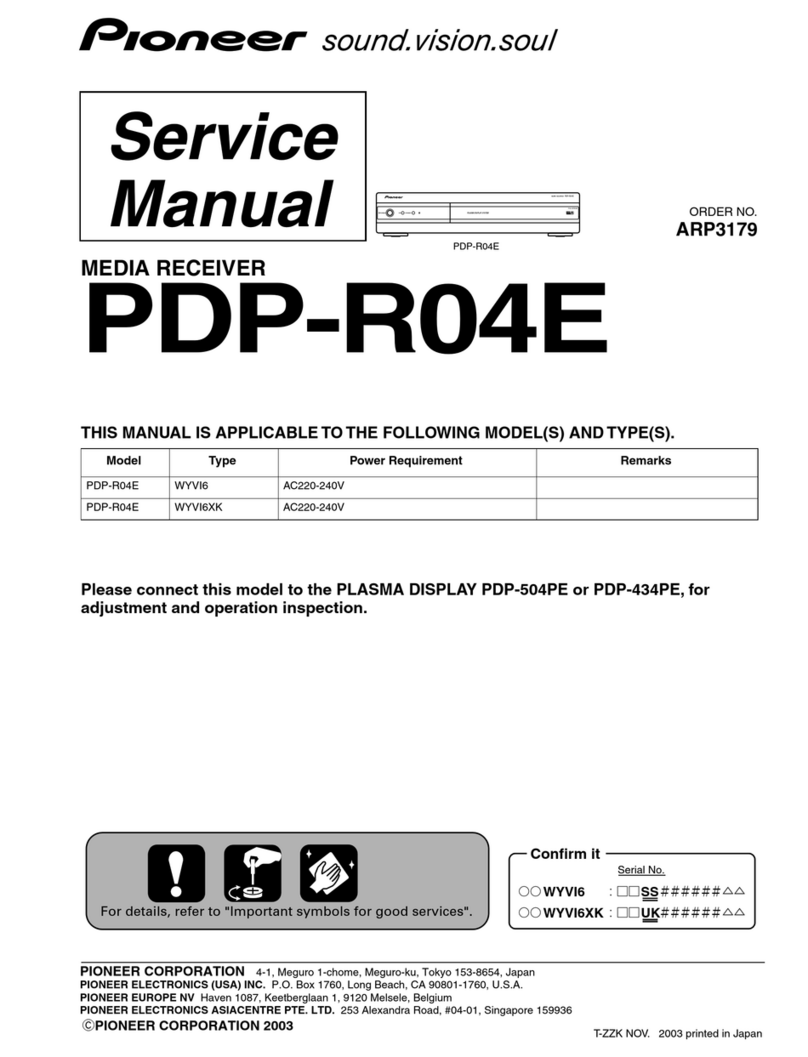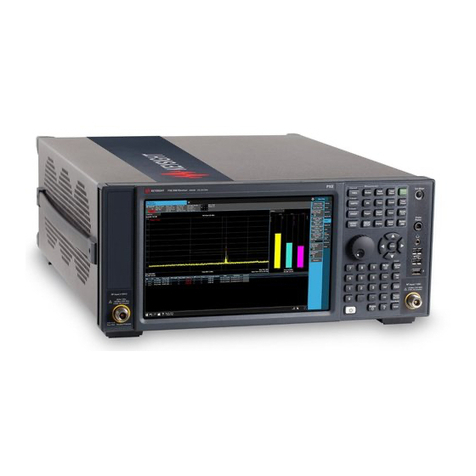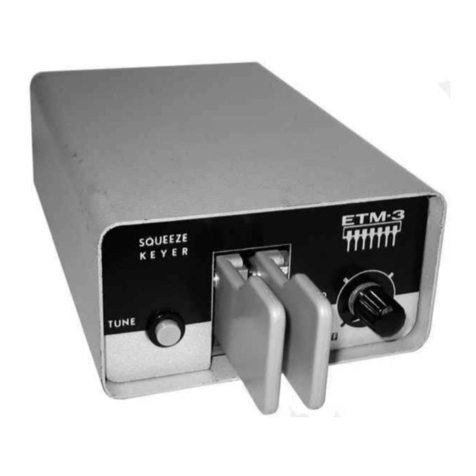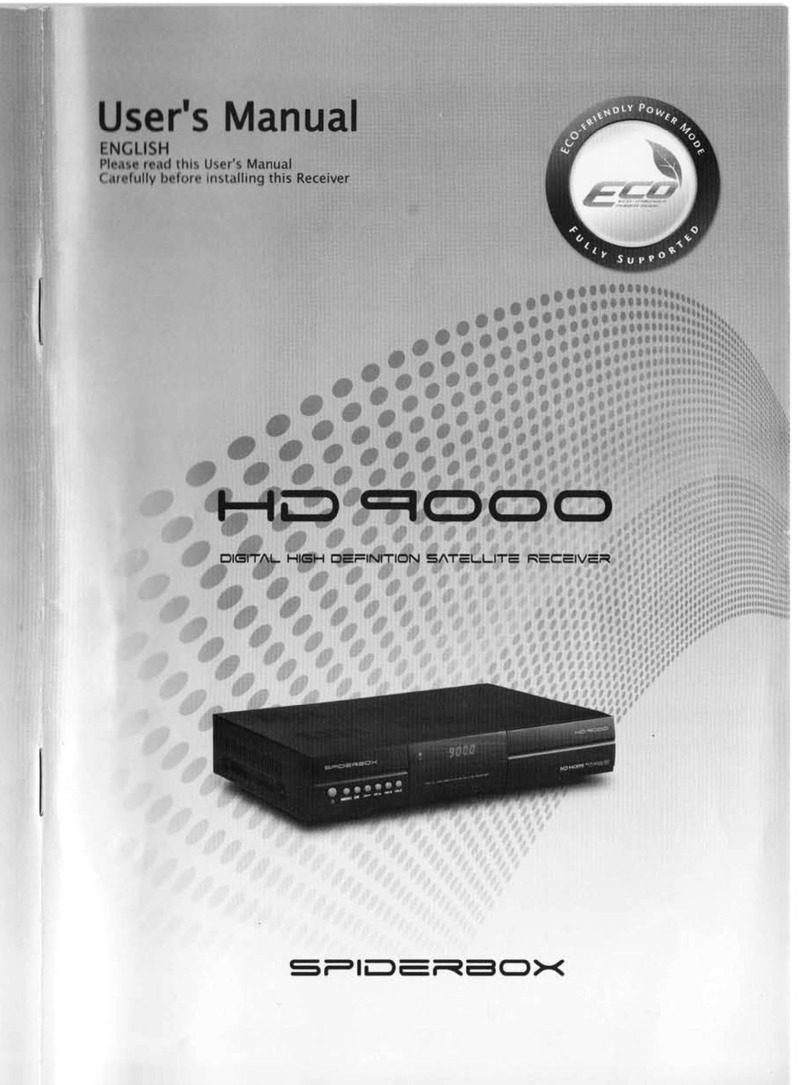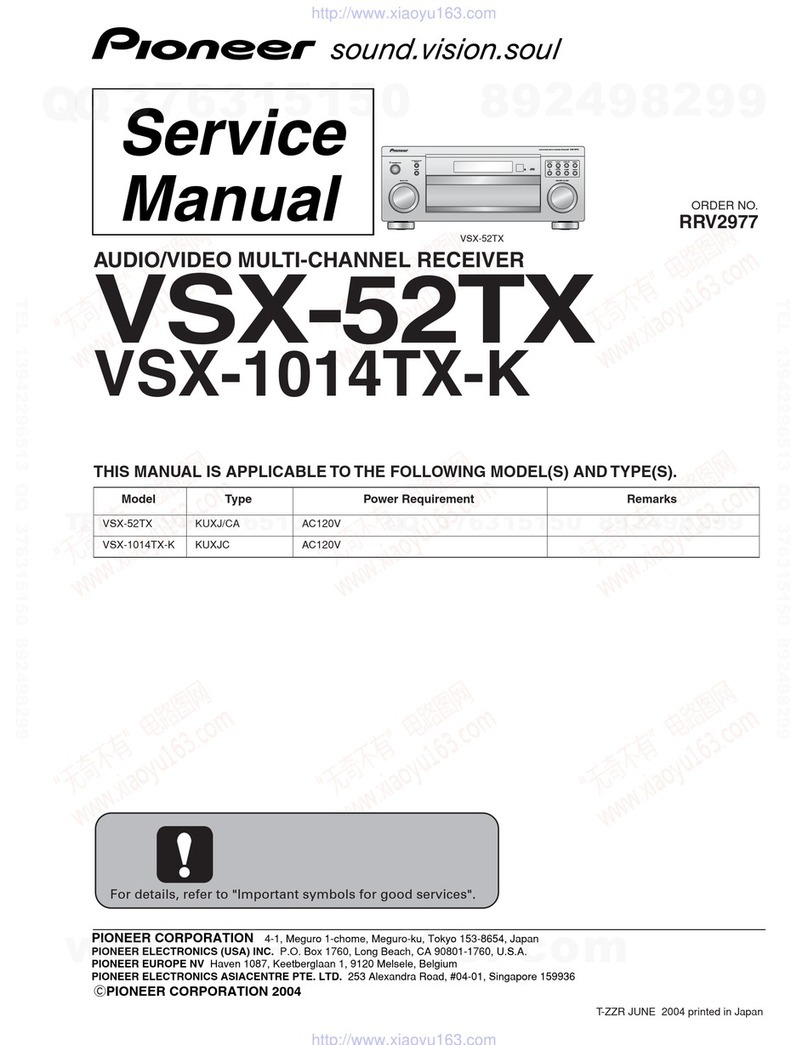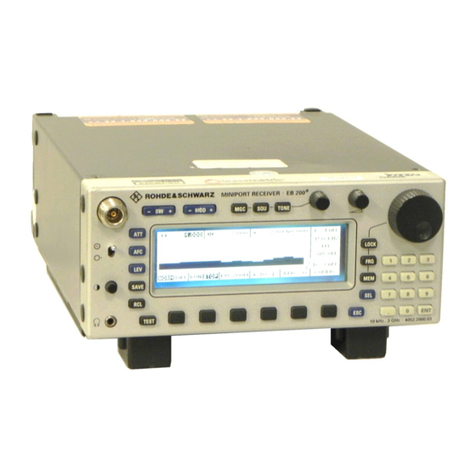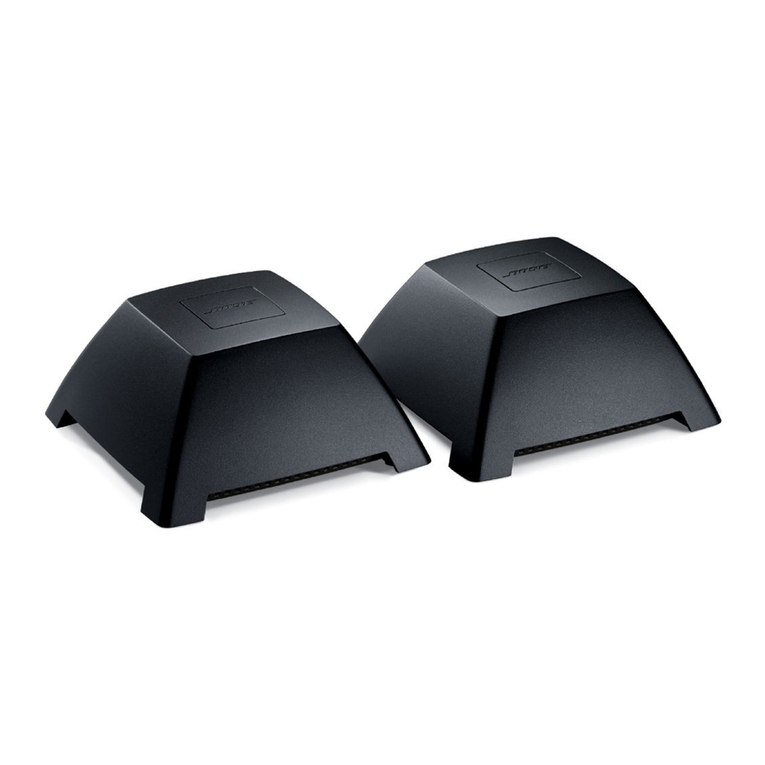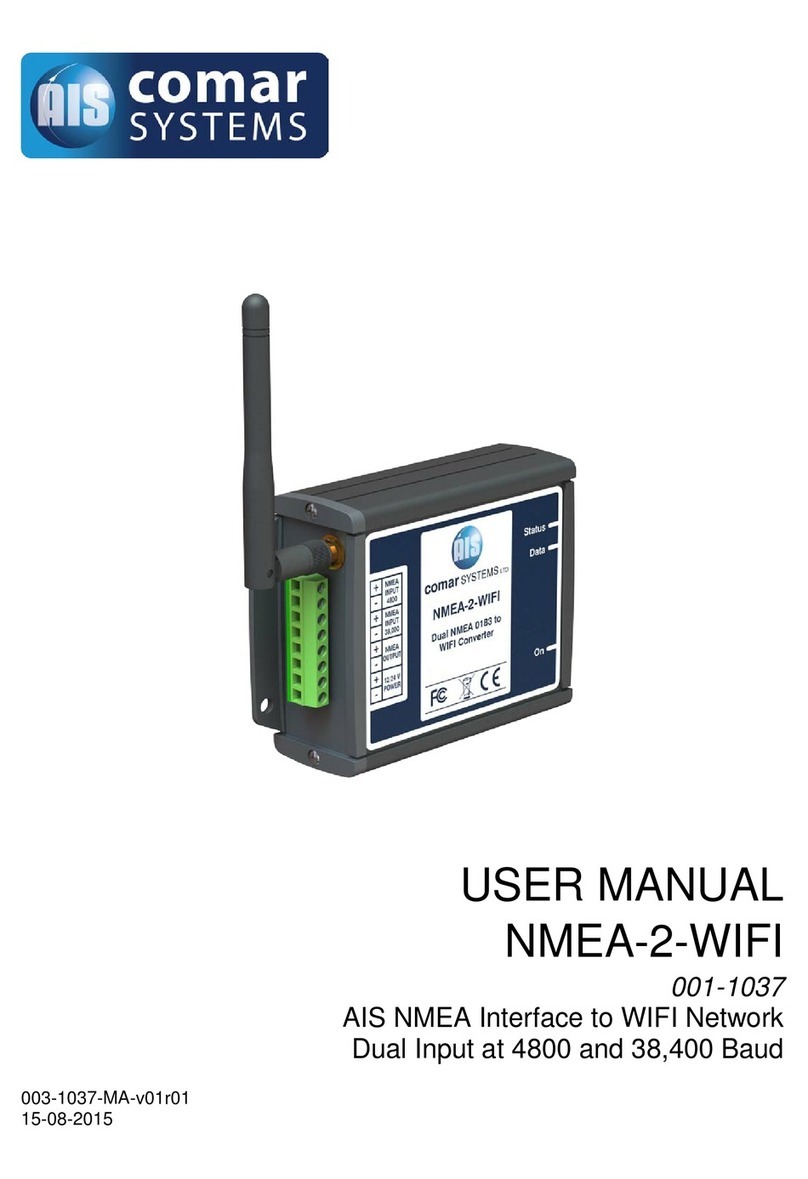
1A - Generalità
Il ricevitore Erone mod. SEL2641 R433-IP ( Fig. 1) è un ricevitore supereterodina a singola conversione, con
decodifica integrata del tipo rolling code e demodulazione AM/ASK. Un sistema interno permette di mantenere
sempre sincronizzati ricevitore e trasmettitore. Il ricevitore, disponendo in uscita di contatti puri, può essere
collegato ad un qualsiasi tipo di meccanismo ( cancello, porta di garage, serrande, tapparelle, tende, centrale
antifurto, illuminazione, ecc.). La programmazione si effettua in autoapprendimento a distanza con il
trasmettitore oppure per mezzo di 2 tasti del ricevitore . Tutti i ricevitori della serie Erone sono in grado di
apprendere e conservare in EEPROM il codice di serie e l’algoritmo di sincronizzazione di più trasmettitori.
Il prodotto è conforme alle direttive Europee 73/23/CEE, 89/336/CEE ed alla normativa EN
60065.
1B - Trasmettitori impiegabili
Erone 024A Mod. S2TR 2641 E2-E4-E2M : Trasmettitore 2/4 Tasti/ Master
Erone 433 Mod. SETR 2641 AM2: Trasmettitore mini 2 Tasti
Erone 433 Mod. SETR 2641 TM: Trasmettitore murale
1C - Caratteristiche tecniche
Tipo di ricevitore: Supereterodina.
Demodulazione: AM/ASK.
Frequenza: 433.92 MHz.
Frequenza dell’oscillatore locale: 6,6128 MHz.
Frequenza intermedia: 10,7 MHz.
Sensibilità ( per segnale a buon fine ): -115 dBm.
Impedenza d’ingresso: 50 Ohm.
Tensione di alimentazione : 12 o 24 V ac/dc.
Assorbimento: a riposo: 25 mA
a carico: 55 mA
Numero di relè: 2 (1NA e 1NA o NC).
Potenza massima commutabile: 24W o 24VA .
Numero di codici memorizzabili: 85.
Temperatura di funzionamento: da -20 a + 70 °C.
Dimensioni ( Fig. 1): 105 x 45 x 28 mm.
Peso: 65 gr.
1D - Funzionalità principali
Autoapprendimento e cancellazione del codice del trasmettitore a distanza senza necessità di accedere all'RX
85 tasti trasmettitore memorizzabili;
Visualizzazione N° utenti in memoria;
Visualizzazione posizione in memoria dell'ultimo codice Tx ricevuto;
Sovrascrittura codice di Tx già presente in memoria;
Cancellazione completa della memoria sia da radiocomando sia da ricevitore;
Funzionamento programmabile dei relè : monostabile, bistabile, ritardato;
Ritardo rilascio dei relè programmabile da 1 sec. a 10 ore.
1E - Legenda Ricevitore ( Fig. 2)
LR: Led Rosso LV: Led Verde
PR: Pulsante Rosso PV: Pulsante Verde
RR: Relè Rosso RV: Relè Verde
2A - Memorizzazione codice dei trasmettitori
Il codice di ogni singolo tasto può essere memorizzato nel ricevitore in 2 modi diversi:
A - Direttamente sul ricevitore, mediante pressione del tasto PR o PV;
B - Per autoapprendimento a distanza, mediante i tasti del radiocomando.
A - Memorizzazione diretta Uscita “Relè Rosso” o “Relè Verde”
1) Selezionare il relè da programmare RR ( relè rosso ) o RV ( relè verde );
2) Premere il tasto corrispondente al relè da programmare del ricevitore PR o PV : il led corrispondente LR (LV)
si accende; rilasciare il tasto PR o PV;
3) Premere il tasto del trasmettitore che si intende memorizzare : il led LR (LV) si spegne ; il relè RR o R V scatta a
conferma dell'avvenuta memorizzazione.
A partire da questo istante ad ogni attivazione il relè programmato RR o RV si eccita, il led corrispondente si
accende ed il led relativo al secondo relè lampeggia .
B - Memorizzazione per autoapprendimento a distanza mediante radiocomando - Uscita
“Relè Rosso”
1) Premere contemporaneamente i tasti A e B del Tx : i led LR ed LV si accendono per un attimo ed il buzzer emette
un bip;
2) Premere il tasto A dello stesso TX per 4 sec.: il led LR si accende di luce continua rossa ed il buzzer emette un bip
continuo=Biiiiiiip;
3) Premere entro 2 sec. il tasto del Tx da memorizzare: il led LR si spegne ed il relè RR si eccita per un istante
Memorizzazione per autoapprendimento a distanza mediante radiocomando - Uscita “Relè
Verde”
1) Premere contemporaneamente i tasti A e B del Tx :i led LR ed LV si accendono per un attimo ed il buzzer emette
un bip;
2) Premere il tasto B dello stesso TX per 4 sec.: il led LV lampeggia ed il buzzer emette un bip intermittente= Bip,
Bip, ..Bip;
3) Premere entro 2 sec. il tasto del Tx da memorizzare: il led LV si spegne ed il relè RV scatta per un istante.
NOTA 1: La memorizzazione per autoapprendimento a distanza dei TX successivi al primo, in un ricevitore non più
vergine, è consentita solo facendo uso di un TX già memorizzato.
Esempio :
Memorizzazione di TX2 con A sul relè RR e B sul relè RL facendo uso di un tx già memorizzato
(TX1)
- Premere il tasto A di TX1 (bip) ; Premere A di TX1 per 4 sec. (Biiiiiiiiiiiip) ; entro 2 sec. premere
A di TX2 .
- Premere il tasto B di TX1 (bip); Premere B di TX1 per 4 sec. (Bip, Bip, ..Bip) ; entro 2 sec.
premere B di TX2
NOTA 2: Il ricevitore è pre-programmato per un comportamento impulsivo dei relè. Per la programmazione dei
relè RR e RV in modo bistabile o ritardato vedere il punto 4.
NOTA 3: La capacità di memoria del ricevitore è di 85 tasti trasmettitore. Ciò significa che un trasmettitore con 4
tasti occupa 4 posizioni di memoria. Di ogni tasto trasmettitore è possibile visualizzare la posizione di memoria
tramite la procedura descritta al punto 2B.Un tasto trasmettitore può essere memorizzato indifferentemente sul relè
rosso RR o sul relè verde RV ma non su entrambi.
RICEVITORE SEL2641R433-IP
2B - Visualizzazione posizione di memoria dei trasmettitori
1) Attivare il tasto trasmettitore di cui si vuole conoscere la posizione di memoria e verificare l'accensione del led
corrispondente e l'attivazione del relè;
2) Premere il tasto PR del ricevitore per1 secondo;
A questo punto il ricevitore comincia una sequenza di 7 accensioni dei led LR ed LV: annotando la sequenza è
possibile risalire alla posizione di memoria in base alla tabella 1:
Led acceso 1 2 3 4 5 6 7
Peso colore verde 1 2 4 8 16 32 64
Peso colore rosso 0 0 0 0 0 0 0
Esempio :
Sequenza di accensione led : LR, LR, LV, LV, LR, LR, LR.
Il numero ottenuto sarà: 0 + 0 + 4 + 8 + 0 + 0 + 0 = 12
Perciò il trasmettitore si trova nella posizione 12 di memoria.
2C - Sovrascrittura codici TX già presenti in memoria
1) Premere PR o PV del ricevitore per 4 sec. , il relativo led si accende;
2) Entro 2 sec. premere PV per 1 sec e verificare lo spegnimento del led;
3) Entro 2 sec dallo spegnimento del led., iniziare ad introdurre la sequenza indicante la posizione da
sovrascrivere. ( ved. tab.1 );
4) Al termine della sequenza verificare l'accensione del led ( verde o rosso a seconda del relè attivato dal
codice da sovrascrivere );
5) Entro 4 sec. premere il tasto del nuovo TX da memorizzare.
3A - Visualizzazione spazio di memoria
1) Premere il tasto PV del ricevitore per 1 secondo;
A questo punto il ricevitore comincia la sequenza di 7 accensioni dei led LR ed LV: in base ad essa è possibile
risalire al numero di celle occupate di memoria secondo la tabella 1.
3B - Memoria piena
Se, al termine del punto 2 della procedura di memorizzazione, premendo il tasto di un trasmettitore da
memorizzare, lampeggiano contemporaneamente entrambi i led LR ed LV, significa che lo spazio di memoria è
esaurito.
3C - Cancellazione completa della memoria
Questa operazione cancella completamente la memoria è possibile sia con il radiocomando sia con i tasti del
ricevitore.
Con il radiocomando
1) Premere contemporaneamente i tasti A + B di un TX con uno o più codici presenti in memoria dell’RX; il buzzer
emette un bip ed i led del RX emettono un breve lampeggio;
2) Entro 2 sec. premere per 4 sec. il tasto A dello stesso TX: il led LR si accende ed il buzzer emette un bip continuo
( Biiiiiip).
3) Entro 4 sec. premere di nuovo contemporaneamente A + B per ulteriori 4 sec. ; a questo punto il RX emetterà
3 bip lunghi del buzzer ( Biiiiiiip - Biiiiiiiip - Biiiiiiiip) e 3 lampeggi di LR e LV e la memoria sarà cancellata.
Con tasti ricevitore
1) Premere il tasto PR del ricevitore fino a che si accende il led rosso LR;
2) Rilasciare PR e successivamente premere e mantenere premuti entrambi i tasti del ricevitore PR e PV per 4 sec.
fino a quando il ricevitore segnala l'avvenuta cancellazione totale con 3 lampeggi dei 2 led e 3 bip del buzzer.
4A - Visualizzazione impostazione dei relè
Premere e mantenere premuto il tasto PR (o PV) del ricevitore per 4 sec. L'impostazione del relè rosso RR ( o verde
RV ) viene mostrata dalle accensioni dei led rosso o verde, secondo la seguente tabella:
Funzionamento relè ( RR o RV ) Messaggio visivo led (LR o LV)
relè impulsivo Luce continua
relè passo-passo Luce intermittente
relè temporizzato luce intermittente veloce
4B - Programmazione relè
I due relè possono essere programmati indifferentemente in modo impulsivo, passo-passo o bistabile, tranne che
per i 2 casi seguenti:
Configurazioni non ammesse Relè Rosso RR Relè Verde
passo-passo ritardato
ritardato ritardato (con tempi diversi)
4C - Impostazione relè RR (RV) - (Fig. 4)
L’impostazione del funzionamento è ciclica come da fig. 2. Per entrare in modifica premere per 4 sec. PR o PV.
Le pressioni successive del tasto PR fanno modificare il modo di funzionamento in passo-passo o in impulsivo.
4E - Temporizzazione relè RR ( RV) -( Fig. 5)
I relè si configurano in modo temporizzato solo a partire dal modo impulsivo.
Premere il tasto PR (PV) del ricevitore per 4 sec.; il led rosso LR (verde LV) si accende ed indica il modo di
funzionamento attuale del relè . Se il funzionamento è passo-passo o temporizzato ( ved. tab. 2) premere ancora
PR per 1 sec. per impostarlo impulsivo. Premere ancora PR per 1 sec e verificare che il led LR (LV) si spegne.
Entro 2 sec. introdurre la sequenza di temporizzazione agendo sui tasti PR e PV in base alla tabella 12, tenendo
conto che PR ha peso 0 e PV ha peso 1.
Esempio 1: ritardo di 8 sec. : Impostare la sequenza : PR - PR - PR - PV - PR - PR - PR.
Esempio 2: ritardo di 2 min.: Impostare la sequenza : PV - PR - PR - PR - PR - PR - PV.
..................................................................................................................................................
GARANZIA
La garanzia è di 24 mesi dalla data di fabbricazione apposta all’interno. Durante tale periodo, se
l’apparecchiatura non funziona correttamente, a causa di un componente difettoso, essa verrà riparata o sostituita
a discrezione del fabbricante. La garanzia non copre l’integrità del contenitore plastico.
La garanzia viene prestata presso la sede del fabbricante.
Tab. 1
1F - Connessioni ( Fig. 2)
Alimentazione : morsetti 1 e 2 : 12 Vac/dc
morsetti 1 e 3 : 24 Vac/dc
Antenna : morsetto 9 : calza ( usare cavo RG58)
morsetto 10 : filo.
Uscite relè : morsetti 4 e 5 : contatto n.a. (relè rosso)
morsetti 6 e 7: contatto n.a. (relè verde)
morsetti 6 e 8: contatto n.c. (relè verde). Tab. 2
ENGLISH
1A - Introduction
The receiver Erone type SEL2641 R433-IP ( Fig. 1) is a superheterodyne single conversion receiver with integrated
rolling-code decoding. The demodulation is AM/ASK.
A special algorithm allows to keep synchronyzed transmitter and receiver.
The receiver which makes the activation, once received the transmitter code, has to be connected during the
installation to the device to control ( gate, garage door, rolling shutters, awnings, anti-burglar appliances, lighting,
etc.). The transmitter memorization can be carried out either with 2 push-buttons of the receiver or far from the
receiver with the keys of the transmitter.
All the receivers of the range Erone 433 can store into the EEPROM a serial number, a manufacturer key and a
synchronism algorithm of more transmitters.
The product fully complies with the European Directives 73/23/CEE, 89/336/CEE and with the
Regulation EN 60065.
1B - Usable transmitters
Erone 024A type S2TR 2641 E2-E4-E2M : Transmitter 2/4 buttons/ Master
Erone 433 type SETR 2641 AM2: : Transmitter mini 2 buttons
Erone 433 type SETR 2641 TM: : Wall Transmitter
RICEVITORE SEL2641R433-IP
Tab. 3
3B - Memory full
When the receiver memory is full and a memorization procedure is started, both the leds LV and LR blink 3 times.
3C - Full memory erase
This operation is possible both with the transmitter keys (1) and with the receiver push buttons (2).
1): Keep on pushed simultaneously the keys A and B of a TX whose codes are presents in the memory of the RX;
the buzzer emits a bip and the leds turns on for a while; within 2 sec. keep on pushed the key A of the same TX for 4
sec.: the led LR is turned on and the buzzer sounds a long bip ( “biiiiiiip”).
Within 4 sec.( before the end of the long bip) push again simultaneously A and B for other 4 sec.; at this point will
occur 3 blinks of LR and LV and 3 long bips of the buzzer ( biiiip - biiiip - biiiip”).
At the end of this operation all the codes TX present in the memory are erased.
2): Keep on pushed PR of the receiver until the red led LR is turned on.
Afterwards, keep on pushed simultaneously PV and PR for 4 sec. The receiver will give the operation
confirmation with 3 blinks of the leds and 3 long bips of the buzzer ( “Biiiiip - Biiiiip - Biiiiip”).
4A - Relay configuration display
Keep on pushed PR (or PV) of the receiver for 4 sec. The configuration of the relay is displayed by the
corresponding led according the following table :
Relay operating mode ( RR or RV ) Led light type (LR or LV)
Pulse relay Continuous light
Latching relay Slow blinking
Timed relay Fast blinking
4B - Relay programming
The receivers are factory set to Pulse mode.To change the mode follow these steps ( Fig. 4) :
1. Press desired relay button on receiver to be programmed ( PV or PR ) for 4 seconds. LED will illuminate
displaying relay status. Use Table 5 to determine the status.
2. Within 1 second press PR to change the relay mode.
The relay mode will change according to the diagram of Fig. 4
Red relay RR Green relay RV
Not allowed configurations latching timed
timed timed (with different delay times)
4C - Relay RR (RV) configuration - Fig. 4
The operating mode of the relay is cyclic, with the possibility to change the mode according the following rules:
-If the relay is set as pulse: it becomes latching and after timed;
-If the relay is set as latching: it becomes pulse;
-If the relay is set as timed: it becomes pulse.
4E - Relay RR ( RV) timing settings - Fig. 5
The modification for the relay settings, with the timing, can be done only if the relay has been set as pulse.
Push the button PR (PV) of the receiver for 4 sec.;the led LR (LV) will turn on and will display the operating mode set
for the relay RR (RV). If the led blinks slow or fast push again PR for 1 second and the relay will be set as pulse. Then
push PR for 1 second and the led LR (LV) switches off. Afterwards, within 2 seconds, begin to insert the selected relay
time, by pushing on the buttons PR and PV according to Table 12 and considering that PR has weight of "0" while PV
has weight "1".
NOTE: The last pressures on PR of the sequence are not necessaries.
Example 1: 8 sec. delay : input the sequence : PR - PR - PR - PV - PR - PR - PR.
Example 2: 2 min delay.: Input the sequence : PV - PR - PR - PR - PR - PR - PV.
..................................................................................................................................................
GUARANTEE
The guarantee period of the product is 24 months, beginning from the manufacturer date. During this period, if the
product does not work correctly, due to a defective component, the product will be repaired or substituted at the
discretion of the producer. The guarantee does not cover the plastic container integrity. After-sale service is supplied
at the producer's factory.
1C - Technical specifications
Receiver type: Superheterodyne.
Demodulation: AM/ASK.
Operating frequency: 433,92 MHz.
Local oscillator frequency: 6,6128 MHz.
Intermediate frequency: 10,7 MHz.
Sensitivity (for good signal): -115 dBm.
Input impedance: 50 Ohm.
Supply voltage : 12 or 24 V ac/dc.
Current consumption: at rest: 25 mA
with relay excited: 55 mA
Number of relays: 2 (1NO, 1NO or NC).
Commutable max power: 24W or 24VA .
Max codes number: 85.
Operating temperature: from -20 to + 70 °C.
Dimensions ( Fig. 1 ): 105 x 45 x 28 mm.
Weight: 65 gr.
1D - Main features
Memory for 85 transmitter keys;
Self-learning and erasing of the transmitter code simply using the transmitter keys, without accessing to the
receiver board;
Display of the transmitter key number;
Display of the memory position for the last memorized transmitter;
Overwrite of a transmitter code;
Programmable operation of the relays: pulsing, latching and timed;
Programmable delay of release for the relays from 1 sec. to 10 hours;
Full memory cancellation.
1E - Receiver detail ( Fig. 2)
LR: Red led LV: Green led
PR: Red push-button PV: Green button
RR: Red relay RV: Green relay
1F - Connections (Fig. 2)
Power-supply : terminals 1 , 2 : 12 Vac/dc Antenna : terminal 9 : shield
terminals 1 , 3 : 24 Vac/dc terminal 10 : core. ( RG 58)
Relay Outputs: terminals 4,5 : NO contact (red relay)
terminals 6,7: NO contact green relay)
terminals 6,8: NC contact green relay)
2A - Transmitter memorizing
The code of each transmitter key can be memorized into the receiver in 2 different ways:
A - Directly on the receiver, by using the receiver push-buttons PR or PV.
B - Far from the receiver, by using the transmitter keys.
A) Direct memorization - To program a transmitter at the receiver.
1 - Select the relay to be programmed Green (PV) or Red (PR)
2 - Push desired relay key for 2 seconds or until LED comes on
3 - Within 2 seconds press desired transmitter key to store in receiver memory.
LED light should blink and relay should cycle.
B) Remote programming mode : To program transmitters thru the use of a transmitter.
Note: To utilize this mode the receiver must first have at least one transmitter programmed into the receiver.
1 - Programming request - Push both keys of the transmitter that is already stored in the receiver until the receiver
“beeps”;
2 - Programming entry - Release both keys and immediatlely press A or B key to select the corresponding relay to be
programmed and hold key for 4 seconds;
The LED light of corresponding relay will turn on and “beep” will be continuous;
3 - Memorization - Within 2 seconds press new transmitter button to be memorized.
Example:
Memorization of a second transmitter ( TX2) with key A on relay red RR and key B on relay green RV into
a receiver with a transmitter (TX1) already stored:
Push keys A+B of TX1(bip); Push key A of TX1 for 4 sec.(Biiiiiiiip); push key A of TX2 within 2
sec.
Push keys A+B of TX1(bip); Push key B of TX1 for 4 sec.(Bip, Bip, ...Bip); push key B of TX2
within 2 sec.
NOTE : The memory capacity is of 85 transmitter keys. That means that a 4 keys transmitter needs 4 memory
positions. It is possible to display the memory position by following the procedure 2B.
A transmitter key can be memorized on each relay RR or RV but not on both.
2B - Display of the transmitter memory position
By following the present procedure it is possible to display the position occupied by a given transmitter key.
1) Push the transmitter key for which it is necessary to know the memory position and verify the activation of the
relay and the led.
2) Push the button PR of the receiver for 1 second.
At this point begins a sequence of 7 total blinks of the two led lights LR and LV: by taking a note of what color light
blinks, it is possible to obtain the memory position, according to the table 4:
Example: Transmitter blinks the following seven times after pushing the red relay (PR) key:
RED - RED - GREEN - GREEN - RED - RED - RED
This corresponds to the 12th position.
2C - Overwrite of an already stored Transmitter code
1 - Determine transmitter key memory position ( see section 2B)
2 - Press corresponding relay programming key on transmitter for 4 seconds.
3 - Within 2 seconds press (PV)
4 - Within 2 seconds enter the transmitter memory position of existing transmitter by using ( PR red ) and (
PV green) accordingly. There must be a total combination of seven button pushed ( PV or PR) to match the
memory position of existing transmitter.
5 - Within 1 second press the new transmitter key to be programmed.
The previous transmitter key will be removed and replaced by the key pressed in step 5.
3A - Memory capacity display
This procedure allows to display the number of occupied memory positions.
1) Push the button PV of the receiver for 1 second.
At this point the receiver begins a sequence of 7 lightings of the leds LR and LV.
Referring to that it is possible to obtain the number of the occupied memory positions, according to tab.4.
DEUTSCH
1 -
2 - Handsender
Erone 024A Mod. S2TR 2641 E2/E4/E2M: Handsender 2,4 Tasten, 2 Tasten Master;
Erone 433 Mod. SETR 2641 AM2: Mini Handsender 2 Tasten;
Erone 433 Mod. SETR 2641 TM: Wand Handsender 4 Tasten;
3 - Technische daten
4 - Funktionen
5 -
Allgemein
Der Empfänger SEL 2641 R433-IP (Abb. 1) ist eine Komponente unseres Funksystems 433, um Automationen und
elektrische sowie elektronische Systeme fern zu steuern. Dank der hochsicheren Codierung, „Rolling Code“,
können wir einen manipulationssicheren Betrieb gewährleisten. Der vom Handsender gesendete Code ändert
sich bei jeder Aktivierung und der Mikrocontroller im Empfänger syncronisiert alle eingelesenen Sender im System.
Die Programmierung erfolgt selbstlernend durch 2 Tasten.
Die Empfänger entspricht den eropäischen Normen 73/23/CEE, 89/336/CEE, EN 60065.
Empfängertyp: Superheterodyne
Modulation: AM/ASK
Frequenz: 433,92 MHz
Frequenz des lokalen Oszillators: 6,6128 MHz
Zwischenfrequenz: 10,7 MHz
Empfindlichkeit(für erfolgreiches Signal): -115 dBm
Eingangsimpedanz: 50 Ohm
Spannungsversorgung: 12/24 VAC/DC
Ruhestrom: 25 mA
Laststrom: 55 mA
Relaisanzahl: 2 ( 1 NO/ 1 NO-NC)
Leistung 24 W
Betriebstemperatur - 20 °C bis + 70 °C
Abmessung ( Abb. 1): 105 x 45 x 28 mm
Funkfernprogrammierung über Handsender (Einlernen und Löschen der Codes);
85 Codes speicherbar;
Anzeige der gespeicherten Codes;
Anzeige der Speicherposition des letzten empfangenen Codes;
Überschreiben von gespeicherten Codes;
Vollständige Löschung des Codespeichers am Empfänger oder über Handsender;
Programmierbare Relais : monostabil, bistabil und Zeitverzögert.
Zeichenerklärung
LR: rote LED
PR: rote Taste
RR: rotes Relais
LV: grüne LED
PV: grüne Taste
RV: grünes Relais
6 - Anschlüsse ( Abb. 2)
Einspeisung: Antenne: ( RG58 )
Klemme 1 und 2: 12 VAC/DC Klemme 9: Schirmung
Klemme 1 und 3: 24 VAC/DC Klemme10: Antenne
Relaisausgang:
Klemme 4 und 5 : Kontakt NO (rotes Relais)
Klemme 6 und 7 : Kontakt NO (grünes Relais)
Klemme 6 und 8 : Kontakt NC (grünes Relais)
Led blinks 1° 2° 3° 4° 5° 6° 7°
Green LED 1 2 4 8 16 32 64
Red LED 0000000
Tab. 4
Tab. 5
Tab. 6
3B - Memory full
When the receiver memory is full and a memorization procedure is started, both the leds LV and LR blink 3 times.
3C - Full memory erase
This operation is possible both with the transmitter keys (1) and with the receiver push buttons (2).
1): Keep on pushed simultaneously the keys A and B of a TX whose codes are presents in the memory of the RX;
the buzzer emits a bip and the leds turns on for a while; within 2 sec. keep on pushed the key A of the same TX for 4
sec.: the led LR is turned on and the buzzer sounds a long bip ( “biiiiiiip”).
Within 4 sec.( before the end of the long bip) push again simultaneously A and B for other 4 sec.; at this point will
occur 3 blinks of LR and LV and 3 long bips of the buzzer ( biiiip - biiiip - biiiip”).
At the end of this operation all the codes TX present in the memory are erased.
2): Keep on pushed PR of the receiver until the red led LR is turned on.
Afterwards, keep on pushed simultaneously PV and PR for 4 sec. The receiver will give the operation
confirmation with 3 blinks of the leds and 3 long bips of the buzzer ( “Biiiiip - Biiiiip - Biiiiip”).
4A - Relay configuration display
Keep on pushed PR (or PV) of the receiver for 4 sec. The configuration of the relay is displayed by the
corresponding led according the following table :
Relay operating mode ( RR or RV ) Led light type (LR or LV)
Pulse relay Continuous light
Latching relay Slow blinking
Timed relay Fast blinking
4B - Relay programming
The receivers are factory set to Pulse mode.To change the mode follow these steps ( Fig. 4) :
1. Press desired relay button on receiver to be programmed ( PV or PR ) for 4 seconds. LED will illuminate
displaying relay status. Use Table 5 to determine the status.
2. Within 1 second press PR to change the relay mode.
The relay mode will change according to the diagram of Fig. 4
Red relay RR Green relay RV
Not allowed configurations latching timed
timed timed (with different delay times)
4C - Relay RR (RV) configuration - Fig. 4
The operating mode of the relay is cyclic, with the possibility to change the mode according the following rules:
-If the relay is set as pulse: it becomes latching and after timed;
-If the relay is set as latching: it becomes pulse;
-If the relay is set as timed: it becomes pulse.
4E - Relay RR ( RV) timing settings - Fig. 5
The modification for the relay settings, with the timing, can be done only if the relay has been set as pulse.
Push the button PR (PV) of the receiver for 4 sec.;the led LR (LV) will turn on and will display the operating mode set
for the relay RR (RV). If the led blinks slow or fast push again PR for 1 second and the relay will be set as pulse. Then
push PR for 1 second and the led LR (LV) switches off. Afterwards, within 2 seconds, begin to insert the selected relay
time, by pushing on the buttons PR and PV according to Table 12 and considering that PR has weight of "0" while PV
has weight "1".
NOTE: The last pressures on PR of the sequence are not necessaries.
Example 1: 8 sec. delay : input the sequence : PR - PR - PR - PV - PR - PR - PR.
Example 2: 2 min delay.: Input the sequence : PV - PR - PR - PR - PR - PR - PV.
..................................................................................................................................................
GUARANTEE
The guarantee period of the product is 24 months, beginning from the manufacturer date. During this period, if the
product does not work correctly, due to a defective component, the product will be repaired or substituted at the
discretion of the producer. The guarantee does not cover the plastic container integrity. After-sale service is supplied
at the producer's factory.
1C - Technical specifications
Receiver type: Superheterodyne.
Demodulation: AM/ASK.
Operating frequency: 433,92 MHz.
Local oscillator frequency: 6,6128 MHz.
Intermediate frequency: 10,7 MHz.
Sensitivity (for good signal): -115 dBm.
Input impedance: 50 Ohm.
Supply voltage : 12 or 24 V ac/dc.
Current consumption: at rest: 25 mA
with relay excited: 55 mA
Number of relays: 2 (1NO, 1NO or NC).
Commutable max power: 24W or 24VA .
Max codes number: 85.
Operating temperature: from -20 to + 70 °C.
Dimensions ( Fig. 1 ): 105 x 45 x 28 mm.
Weight: 65 gr.
1D - Main features
Memory for 85 transmitter keys;
Self-learning and erasing of the transmitter code simply using the transmitter keys, without accessing to the
receiver board;
Display of the transmitter key number;
Display of the memory position for the last memorized transmitter;
Overwrite of a transmitter code;
Programmable operation of the relays: pulsing, latching and timed;
Programmable delay of release for the relays from 1 sec. to 10 hours;
Full memory cancellation.
1E - Receiver detail ( Fig. 2)
LR: Red led LV: Green led
PR: Red push-button PV: Green button
RR: Red relay RV: Green relay
1F - Connections (Fig. 2)
Power-supply : terminals 1 , 2 : 12 Vac/dc Antenna : terminal 9 : shield
terminals 1 , 3 : 24 Vac/dc terminal 10 : core. ( RG 58)
Relay Outputs: terminals 4,5 : NO contact (red relay)
terminals 6,7: NO contact green relay)
terminals 6,8: NC contact green relay)
2A - Transmitter memorizing
The code of each transmitter key can be memorized into the receiver in 2 different ways:
A - Directly on the receiver, by using the receiver push-buttons PR or PV.
B - Far from the receiver, by using the transmitter keys.
A) Direct memorization - To program a transmitter at the receiver.
1 - Select the relay to be programmed Green (PV) or Red (PR)
2 - Push desired relay key for 2 seconds or until LED comes on
3 - Within 2 seconds press desired transmitter key to store in receiver memory.
LED light should blink and relay should cycle.
B) Remote programming mode : To program transmitters thru the use of a transmitter.
Note: To utilize this mode the receiver must first have at least one transmitter programmed into the receiver.
1 - Programming request - Push both keys of the transmitter that is already stored in the receiver until the receiver
“beeps”;
2 - Programming entry - Release both keys and immediatlely press A or B key to select the corresponding relay to be
programmed and hold key for 4 seconds;
The LED light of corresponding relay will turn on and “beep” will be continuous;
3 - Memorization - Within 2 seconds press new transmitter button to be memorized.
Example: Memorization of a second transmitter ( TX2) with key A on relay red RR and key B on relay green RV into
a receiver with a transmitter (TX1) already stored:
Push keys A+B of TX1(bip); Push key A of TX1 for 4 sec.(Biiiiiiiip); push key A of TX2 within 2
sec.
Push keys A+B of TX1(bip); Push key B of TX1 for 4 sec.(Bip, Bip, ...Bip); push key B of TX2
within 2 sec.
NOTE : The memory capacity is of 85 transmitter keys. That means that a 4 keys transmitter needs 4 memory
positions. It is possible to display the memory position by following the procedure 2B.
A transmitter key can be memorized on each relay RR or RV but not on both.
2B - Display of the transmitter memory position
By following the present procedure it is possible to display the position occupied by a given transmitter key.
1) Push the transmitter key for which it is necessary to know the memory position and verify the activation of the
relay and the led.
2) Push the button PR of the receiver for 1 second.
At this point begins a sequence of 7 total blinks of the two led lights LR and LV: by taking a note of what color light
blinks, it is possible to obtain the memory position, according to the table 4:
Example: Transmitter blinks the following seven times after pushing the red relay (PR) key:
RED - RED - GREEN - GREEN - RED - RED - RED
This corresponds to the 12th position.
2C - Overwrite of an already stored Transmitter code
1 - Determine transmitter key memory position ( see section 2B)
2 - Press corresponding relay programming key on transmitter for 4 seconds.
3 - Within 2 seconds press (PV)
4 - Within 2 seconds enter the transmitter memory position of existing transmitter by using ( PR red ) and (
PV green) accordingly. There must be a total combination of seven button pushed ( PV or PR) to match the
memory position of existing transmitter.
5 - Within 1 second press the new transmitter key to be programmed.
The previous transmitter key will be removed and replaced by the key pressed in step 5.
3A - Memory capacity display
This procedure allows to display the number of occupied memory positions.
1) Push the button PV of the receiver for 1 second.
At this point the receiver begins a sequence of 7 lightings of the leds LR and LV.
Referring to that it is possible to obtain the number of the occupied memory positions, according to tab.4.
DEUTSCH
1 -
2 - Handsender
Erone 024A Mod. S2TR 2641 E2/E4/E2M: Handsender 2,4 Tasten, 2 Tasten Master;
Erone 433 Mod. SETR 2641 AM2: Mini Handsender 2 Tasten;
Erone 433 Mod. SETR 2641 TM: Wand Handsender 4 Tasten;
3 - Technische daten
4 - Funktionen
5 -
Allgemein
Der Empfänger SEL 2641 R433-IP (Abb. 1) ist eine Komponente unseres Funksystems 433, um Automationen und
elektrische sowie elektronische Systeme fern zu steuern. Dank der hochsicheren Codierung, „Rolling Code“,
können wir einen manipulationssicheren Betrieb gewährleisten. Der vom Handsender gesendete Code ändert
sich bei jeder Aktivierung und der Mikrocontroller im Empfänger syncronisiert alle eingelesenen Sender im System.
Die Programmierung erfolgt selbstlernend durch 2 Tasten.
Die Empfänger entspricht den eropäischen Normen 73/23/CEE, 89/336/CEE, EN 60065.
Empfängertyp: Superheterodyne
Modulation: AM/ASK
Frequenz: 433,92 MHz
Frequenz des lokalen Oszillators: 6,6128 MHz
Zwischenfrequenz: 10,7 MHz
Empfindlichkeit(für erfolgreiches Signal): -115 dBm
Eingangsimpedanz: 50 Ohm
Spannungsversorgung: 12/24 VAC/DC
Ruhestrom: 25 mA
Laststrom: 55 mA
Relaisanzahl: 2 ( 1 NO/ 1 NO-NC)
Leistung 24 W
Betriebstemperatur - 20 °C bis + 70 °C
Abmessung ( Abb. 1): 105 x 45 x 28 mm
Funkfernprogrammierung über Handsender (Einlernen und Löschen der Codes);
85 Codes speicherbar;
Anzeige der gespeicherten Codes;
Anzeige der Speicherposition des letzten empfangenen Codes;
Überschreiben von gespeicherten Codes;
Vollständige Löschung des Codespeichers am Empfänger oder über Handsender;
Programmierbare Relais : monostabil, bistabil und Zeitverzögert.
Zeichenerklärung
LR: rote LED
PR: rote Taste
RR: rotes Relais
LV: grüne LED
PV: grüne Taste
RV: grünes Relais
6 - Anschlüsse ( Abb. 2)
Einspeisung: Antenne: ( RG58 )
Klemme 1 und 2: 12 VAC/DC Klemme 9: Schirmung
Klemme 1 und 3: 24 VAC/DC Klemme10: Antenne
Relaisausgang:
Klemme 4 und 5 : Kontakt NO (rotes Relais)
Klemme 6 und 7 : Kontakt NO (grünes Relais)
Klemme 6 und 8 : Kontakt NC (grünes Relais)
Led blinks 1° 2° 3° 4° 5° 6° 7°
Green LED 1 2 4 8 16 32 64
Red LED 0000000
Tab. 4
3B - Memory full
When the receiver memory is full and a memorization procedure is started, both the leds LV and LR blink 3 times.
3C - Full memory erase
This operation is possible both with the transmitter keys (1) and with the receiver push buttons (2).
1): Keep on pushed simultaneously the keys A and B of a TX whose codes are presents in the memory of the RX;
the buzzer emits a bip and the leds turns on for a while; within 2 sec. keep on pushed the key A of the same TX for 4
sec.: the led LR is turned on and the buzzer sounds a long bip ( “biiiiiiip”).
Within 4 sec.( before the end of the long bip) push again simultaneously A and B for other 4 sec.; at this point will
occur 3 blinks of LR and LV and 3 long bips of the buzzer ( biiiip - biiiip - biiiip”).
At the end of this operation all the codes TX present in the memory are erased.
2): Keep on pushed PR of the receiver until the red led LR is turned on.
Afterwards, keep on pushed simultaneously PV and PR for 4 sec. The receiver will give the operation
confirmation with 3 blinks of the leds and 3 long bips of the buzzer ( “Biiiiip - Biiiiip - Biiiiip”).
4A - Relay configuration display
Keep on pushed PR (or PV) of the receiver for 4 sec. The configuration of the relay is displayed by the
corresponding led according the following table :
Relay operating mode ( RR or RV ) Led light type (LR or LV)
Pulse relay Continuous light
Latching relay Slow blinking
Timed relay Fast blinking
4B - Relay programming
The receivers are factory set to Pulse mode.To change the mode follow these steps ( Fig. 4) :
1. Press desired relay button on receiver to be programmed ( PV or PR ) for 4 seconds. LED will illuminate
displaying relay status. Use Table 5 to determine the status.
2. Within 1 second press PR to change the relay mode.
The relay mode will change according to the diagram of Fig. 4
Red relay RR Green relay RV
Not allowed configurations latching timed
timed timed (with different delay times)
4C - Relay RR (RV) configuration - Fig. 4
The operating mode of the relay is cyclic, with the possibility to change the mode according the following rules:
-If the relay is set as pulse: it becomes latching and after timed;
-If the relay is set as latching: it becomes pulse;
-If the relay is set as timed: it becomes pulse.
4E - Relay RR ( RV) timing settings - Fig. 5
The modification for the relay settings, with the timing, can be done only if the relay has been set as pulse.
Push the button PR (PV)
of the receiver for 4 sec.;the led LR (LV) will turn on and will display the operating mode set
for the relay RR (RV). If the led blinks slow or fast push again PR for 1 second and the relay will be set as pulse. Then
push PR for 1 second and the led LR (LV) switches off. Afterwards, within 2 seconds, begin to insert the selected relay
time, by pushing on the buttons PR and PV according to Table 12 and considering that PR has weight of "0" while PV
has weight "1".
NOTE: The last pressures on PR of the sequence are not necessaries.
Example 1: 8 sec. delay : input the sequence : PR - PR - PR - PV - PR - PR - PR.
Example 2: 2 min delay.: Input the sequence : PV - PR - PR - PR - PR - PR - PV.
..................................................................................................................................................
GUARANTEE
The guarantee period of the product is 24 months, beginning from the manufacturer date. During this period, if the
product does not work correctly, due to a defective component, the product will be repaired or substituted at the
discretion of the producer. The guarantee does not cover the plastic container integrity. After-sale service is supplied
at the producer's factory.
1C - Technical specifications
Receiver type: Superheterodyne.
Demodulation: AM/ASK.
Operating frequency: 433,92 MHz.
Local oscillator frequency: 6,6128 MHz.
Intermediate frequency: 10,7 MHz.
Sensitivity (for good signal): -115 dBm.
Input impedance: 50 Ohm.
Supply voltage : 12 or 24 V ac/dc.
Current consumption: at rest: 25 mA
with relay excited: 55 mA
Number of relays: 2 (1NO, 1NO or NC).
Commutable max power: 24W or 24VA .
Max codes number: 85.
Operating temperature: from -20 to + 70 °C.
Dimensions ( Fig. 1 ): 105 x 45 x 28 mm.
Weight: 65 gr.
1D - Main features
Memory for 85 transmitter keys;
Self-learning and erasing of the transmitter code simply using the transmitter keys, without accessing to the
receiver board;
Display of the transmitter key number;
Display of the memory position for the last memorized transmitter;
Overwrite of a transmitter code;
Programmable operation of the relays: pulsing, latching and timed;
Programmable delay of release for the relays from 1 sec. to 10 hours;
Full memory cancellation.
1E - Receiver detail ( Fig. 2)
LR: Red led LV: Green led
PR: Red push-button PV: Green button
RR: Red relay RV: Green relay
1F - Connections (Fig. 2)
Power-supply : terminals 1 , 2 : 12 Vac/dc Antenna : terminal 9 : shield
terminals 1 , 3 : 24 Vac/dc terminal 10 : core. ( RG 58)
Relay Outputs: terminals 4,5 : NO contact (red relay)
terminals 6,7: NO contact green relay)
terminals 6,8: NC contact green relay)
2A - Transmitter memorizing
The code of each transmitter key can be memorized into the receiver in 2 different ways:
A - Directly on the receiver, by using the receiver push-buttons PR or PV.
B - Far from the receiver, by using the transmitter keys.
A) Direct memorization - To program a transmitter at the receiver.
1 - Select the relay to be programmed Green (PV) or Red (PR)
2 - Push desired relay key for 2 seconds or until LED comes on
3 - Within 2 seconds press desired transmitter key to store in receiver memory.
LED light should blink and relay should cycle.
B) Remote programming mode : To program transmitters thru the use of a transmitter.
Note: To utilize this mode the receiver must first have at least one transmitter programmed into the receiver.
1 - Programming request - Push both keys of the transmitter that is already stored in the receiver until the receiver
“beeps”;
2 - Programming entry - Release both keys and immediatlely press A or B key to select the corresponding relay to be
programmed and hold key for 4 seconds;
The LED light of corresponding relay will turn on and “beep” will be continuous;
3 - Memorization - Within 2 seconds press new transmitter button to be memorized.
Example: Memorization of a second transmitter ( TX2) with key A on relay red RR and key B on relay green RV into
a receiver with a transmitter (TX1) already stored:
Push keys A+B of TX1(bip); Push key A of TX1 for 4 sec.(Biiiiiiiip); push key A of TX2 within 2
sec.
Push keys A+B of TX1(bip); Push key B of TX1 for 4 sec.(Bip, Bip, ...Bip); push key B of TX2
within 2 sec.
NOTE : The memory capacity is of 85 transmitter keys. That means that a 4 keys transmitter needs 4 memory
positions. It is possible to display the memory position by following the procedure 2B.
A transmitter key can be memorized on each relay RR or RV but not on both.
2B - Display of the transmitter memory position
By following the present procedure it is possible to display the position occupied by a given transmitter key.
1) Push the transmitter key for which it is necessary to know the memory position and verify the activation of the
relay and the led.
2) Push the button PR of the receiver for 1 second.
At this point begins a sequence of 7 total blinks of the two led lights LR and LV: by taking a note of what color light
blinks, it is possible to obtain the memory position, according to the table 4:
Example: Transmitter blinks the following seven times after pushing the red relay (PR) key:
RED - RED - GREEN - GREEN - RED - RED - RED
This corresponds to the 12th position.
2C - Overwrite of an already stored Transmitter code
1 - Determine transmitter key memory position ( see section 2B)
2 - Press corresponding relay programming key on transmitter for 4 seconds.
3 - Within 2 seconds press (PV)
4 - Within 2 seconds enter the transmitter memory position of existing transmitter by using ( PR red ) and (
PV green) accordingly. There must be a total combination of seven button pushed ( PV or PR) to match the
memory position of existing transmitter.
5 - Within 1 second press the new transmitter key to be programmed.
The previous transmitter key will be removed and replaced by the key pressed in step 5.
3A - Memory capacity display
This procedure allows to display the number of occupied memory positions.
1) Push the button PV of the receiver for 1 second.
At this point the receiver begins a sequence of 7 lightings of the leds LR and LV.
Referring to that it is possible to obtain the number of the occupied memory positions, according to tab.4.
DEUTSCH
1 -
2 - Handsender
Erone 024A Mod. S2TR 2641 E2/E4/E2M: Handsender 2,4 Tasten, 2 Tasten Master;
Erone 433 Mod. SETR 2641 AM2: Mini Handsender 2 Tasten;
Erone 433 Mod. SETR 2641 TM: Wand Handsender 4 Tasten;
3 - Technische daten
4 - Funktionen
5 -
Allgemein
Der Empfänger SEL 2641 R433-IP (Abb. 1) ist eine Komponente unseres Funksystems 433, um Automationen und
elektrische sowie elektronische Systeme fern zu steuern. Dank der hochsicheren Codierung, „Rolling Code“,
können wir einen manipulationssicheren Betrieb gewährleisten. Der vom Handsender gesendete Code ändert
sich bei jeder Aktivierung und der Mikrocontroller im Empfänger syncronisiert alle eingelesenen Sender im System.
Die Programmierung erfolgt selbstlernend durch 2 Tasten.
Die Empfänger entspricht den eropäischen Normen 73/23/CEE, 89/336/CEE, EN 60065.
Empfängertyp: Superheterodyne
Modulation: AM/ASK
Frequenz: 433,92 MHz
Frequenz des lokalen Oszillators: 6,6128 MHz
Zwischenfrequenz: 10,7 MHz
Empfindlichkeit(für erfolgreiches Signal): -115 dBm
Eingangsimpedanz: 50 Ohm
Spannungsversorgung: 12/24 VAC/DC
Ruhestrom: 25 mA
Laststrom: 55 mA
Relaisanzahl: 2 ( 1 NO/ 1 NO-NC)
Leistung 24 W
Betriebstemperatur - 20 °C bis + 70 °C
Abmessung ( Abb. 1): 105 x 45 x 28 mm
Funkfernprogrammierung über Handsender (Einlernen und Löschen der Codes);
85 Codes speicherbar;
Anzeige der gespeicherten Codes;
Anzeige der Speicherposition des letzten empfangenen Codes;
Überschreiben von gespeicherten Codes;
Vollständige Löschung des Codespeichers am Empfänger oder über Handsender;
Programmierbare Relais : monostabil, bistabil und Zeitverzögert.
Zeichenerklärung
LR: rote LED
PR: rote Taste
RR: rotes Relais
LV: grüne LED
PV: grüne Taste
RV: grünes Relais
6 - Anschlüsse ( Abb. 2)
Einspeisung: Antenne: ( RG58 )
Klemme 1 und 2: 12 VAC/DC Klemme 9: Schirmung
Klemme 1 und 3: 24 VAC/DC Klemme10: Antenne
Relaisausgang:
Klemme 4 und 5 : Kontakt NO (rotes Relais)
Klemme 6 und 7 : Kontakt NO (grünes Relais)
Klemme 6 und 8 : Kontakt NC (grünes Relais)
Led blinks 1° 2° 3° 4° 5° 6° 7°
Green LED 1 2 4 8 16 32 64
Red LED 0000000
Tab. 4
Tab. 5
Tab. 6
RECEIVER SEL2641R433-IP
For more information:
www.devancocanada.com
or call toll free at 855-931-3334


